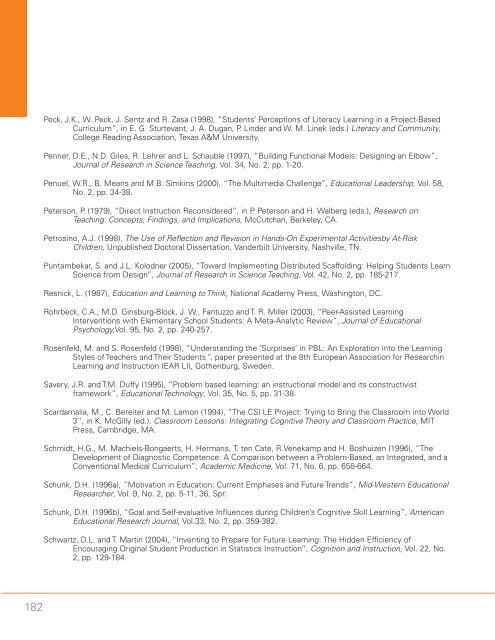del aprendizaje
2aGaJxc
2aGaJxc
Create successful ePaper yourself
Turn your PDF publications into a flip-book with our unique Google optimized e-Paper software.
Peck, J.K., W. Peck, J. Sentz and R. Zasa (1998), “Students’ Perceptions of Literacy Learning in a Project-Based<br />
Curriculum”, in E. G. Sturtevant, J. A. Dugan, P. Linder and W. M. Linek (eds.) Literacy and Community,<br />
College Reading Association, Texas A&M University.<br />
Penner, D.E., N.D. Giles, R. Lehrer and L. Schauble (1997), “Building Functional Mo<strong>del</strong>s: Designing an Elbow”,<br />
Journal of Research in Science Teaching, Vol. 34, No. 2, pp. 1-20.<br />
Penuel, W.R., B. Means and M.B. Simkins (2000), “The Multimedia Challenge”, Educational Leadership, Vol. 58,<br />
No. 2, pp. 34-38.<br />
Peterson, P. (1979), “Direct Instruction Reconsidered”, in P. Peterson and H. Walberg (eds.), Research on<br />
Teaching: Concepts, Findings, and Implications, McCutchan, Berkeley, CA.<br />
Petrosino, A.J. (1998), The Use of Reflection and Revision in Hands-On Experimental Activitiesby At-Risk<br />
Children, Unpublished Doctoral Dissertation, Vanderbilt University, Nashville, TN.<br />
Puntambekar, S. and J.L. Kolodner (2005), “Toward Implementing Distributed Scaffolding: Helping Students Learn<br />
Science from Design”, Journal of Research in Science Teaching, Vol. 42, No. 2, pp. 185-217.<br />
Resnick, L. (1987), Education and Learning to Think, National Academy Press, Washington, DC.<br />
Rohrbeck, C.A., M.D. Ginsburg-Block, J. W., Fantuzzo and T. R. Miller (2003), “Peer-Assisted Learning<br />
Interventions with Elementary School Students: A Meta-Analytic Review”, Journal of Educational<br />
Psychology,Vol. 95, No. 2, pp. 240-257.<br />
Rosenfeld, M. and S. Rosenfeld (1998), “Understanding the ‘Surprises’ in PBL: An Exploration into the Learning<br />
Styles of Teachers and Their Students”, paper presented at the 8th European Association for Researchin<br />
Learning and Instruction (EAR LI), Gothenburg, Sweden.<br />
Savery, J.R. and T.M. Duffy (1995), “Problem based learning: an instructional mo<strong>del</strong> and its constructivist<br />
framework”, Educational Technology, Vol. 35, No. 5, pp. 31-38.<br />
Scardamalia, M., C. Bereiter and M. Lamon (1994), “The CSI LE Project: Trying to Bring the Classroom into World<br />
3”, in K. McGilly (ed.), Classroom Lessons: Integrating Cognitive Theory and Classroom Practice, MIT<br />
Press, Cambridge, MA.<br />
Schmidt, H.G., M. Machiels-Bongaerts, H. Hermans, T. ten Cate, R.Venekamp and H. Boshuizen (1996), “The<br />
Development of Diagnostic Competence: A Comparison between a Problem-Based, an Integrated, and a<br />
Conventional Medical Curriculum”, Academic Medicine, Vol. 71, No. 6, pp. 658-664.<br />
Schunk, D.H. (1996a), “Motivation in Education: Current Emphases and Future Trends”, Mid-Western Educational<br />
Researcher, Vol. 9, No. 2, pp. 5-11, 36, Spr.<br />
Schunk, D.H. (1996b), “Goal and Self-evaluative Influences during Children’s Cognitive Skill Learning”, American<br />
Educational Research Journal, Vol.33, No. 2, pp. 359-382.<br />
Schwartz, D.L. and T. Martin (2004), “Inventing to Prepare for Future Learning: The Hidden Efficiency of<br />
Encouraging Original Student Production in Statistics Instruction”, Cognition and Instruction, Vol. 22, No.<br />
2, pp. 129-184.<br />
182


